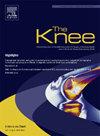髌腱侧偏角:用于评估髌骨不稳的一种新的计算机断层扫描测量方法。
IF 1.6
4区 医学
Q3 ORTHOPEDICS
引用次数: 0
摘要
背景:胫骨结节-跗骨沟(TT-TG)距离是评估髌骨不稳定性的重要参考指标。然而,TT-TG 距离的测量存在可重复性相对较低的缺点。本研究旨在探讨单张计算机断层扫描(CT)片上测量的髌腱侧偏角(PTLD-A)的可靠性及其对预测髌骨不稳的临床意义:研究组包括78个复发性髌骨脱位的膝关节,对照组包括76个正常膝关节。在CT图像上测量PTLD-A和TT-TG距离,评估观察者之间和观察者内部的重复性,分析相关性,并进行组间比较。利用接收者操作特征曲线检验了这两项测量对髌骨不稳的预测价值,并利用尤登指数预测了临界值:结果:在两组中,PTLD-A的观察者间和观察者内再现性均优于TT-TG距离,也优于所有范围的髌骨类型。两种测量结果之间的相关性很强(r = 0.756,P 结论:PTLD-A 和 TT-TG 测量结果之间的相关性很强:在预测髌骨不稳方面,股骨远端套骨沟单片计算机断层扫描测量的PTLD-A比TT-TG距离更可靠。PTLD-A≥13.7°可预测髌骨不稳。本文章由计算机程序翻译,如有差异,请以英文原文为准。
Patellar tendon lateral deviation angle: a new computed tomography scan measurement for evaluation of patellar instability
Background
The tibial tuberosity–trochlear groove (TT-TG) distance is an important reference for the evaluation of patellar instability. However, measurement of the TT-TG distance has disadvantages with relatively low reproducibility. This study aimed to investigate the reliability of patellar tendon lateral deviation angle (PTLD-A) measured on a single computed tomography (CT) slice and the clinical significance for predicting patellar instability.
Methods
Seventy-eight knees with recurrent patellar dislocation were included as the study group, and 76 normal knees in the control group. The PTLD-A and the TT-TG distance were measured on CT images, inter- and intra-observer reproducibility were assessed, and correlation was analyzed, and compared between the groups. The predictive value of both measurements for patellar instability was examined using the receiver operating characteristic curve, and the cut-off value was predicted using the Youden index.
Results
Inter- and intra-observer reproducibility of PTLD-A was better than TT-TG distance in both groups as well as across all extents of trochlear types. The correlation between the two measurements was strong (r = 0.756, P < 0.001). Notably, both measurements were significantly higher in the study group than in the control group (P < 0.05). PTLD-A showed high predictive value for patellar instability, whereas TT-TG distance showed medium predictive value. A PTLD-A value of ≥ 13.7° was the threshold for diagnosis of patellar instability.
Conclusion
PTLD-A measured on a single computed tomography slice of the distal femoral trochlear groove is more reliable than TT-TG distance for prediction of patellar instability. A PTLD-A ≥ 13.7° predicts patellar instability.
求助全文
通过发布文献求助,成功后即可免费获取论文全文。
去求助
来源期刊

Knee
医学-外科
CiteScore
3.80
自引率
5.30%
发文量
171
审稿时长
6 months
期刊介绍:
The Knee is an international journal publishing studies on the clinical treatment and fundamental biomechanical characteristics of this joint. The aim of the journal is to provide a vehicle relevant to surgeons, biomedical engineers, imaging specialists, materials scientists, rehabilitation personnel and all those with an interest in the knee.
The topics covered include, but are not limited to:
• Anatomy, physiology, morphology and biochemistry;
• Biomechanical studies;
• Advances in the development of prosthetic, orthotic and augmentation devices;
• Imaging and diagnostic techniques;
• Pathology;
• Trauma;
• Surgery;
• Rehabilitation.
 求助内容:
求助内容: 应助结果提醒方式:
应助结果提醒方式:


